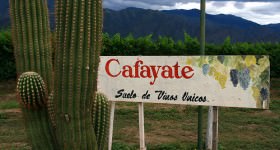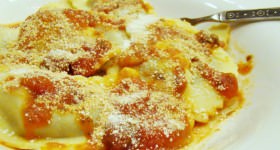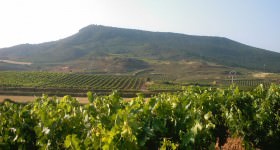Following on from our ‘Take 5’ Argentine sommelier focus, The Real Argentina invited five leading sommeliers from around the world to each champion an Argentine grape and its food pairing potential. Andrew Catchpole samples the suggestions.
 Olivier Gasselin of Hakkasan.
Olivier Gasselin of Hakkasan.Olivier Gasselin: Torrontés
Senior Sommelier, Hakkasan Group (Dubai, UAE and Shanghai, China)
The Grape
Torrontés offers a very wide variety of aromas and flavours, not dissimilar in a way to Gewurztraminer, but with an intrinsic Argentinian pedigree. It is a sensual, generous and highly attractive variety.
A Taster
Torrontés is often exotic, with great ripeness, can be luscious and, in some cases, medium or off-dry. It really depends on winemaking, but it can range from lemon-lime in character, with great intensity and fine acidity, to the more opulent and tropical, with spicy character and mango guava notes. The best can develop great minerality.
A Fact
This is a variety unique to Argentina and one that tastes like nothing else in the world!
With Food
Torrontés works well with a great variety of dishes and styles. The obvious choice would be to match it with spicy food, like Szechuan, Thai or Burmese food, but it also complements many European dishes where good fruit character and high acidity are called for.
A Perfect Pairing
Torrontés would be a delightful match to one of our signature dishes, also on our Shanghai menu, called Charcoal Grilled Chilean Seabass with Chinese honey. This dish is challenging for wine, as it is a little sweet – the flesh of the fish is quite fat, and there is also a bitter-sweet aftertaste, accompanied by a savoury character. Torrontés would work as a catalyzer, bringing balance and extra depth, with its fruit and aromatic intensity bringing out the finesse and complex depths of the dish!
 Laura Rhys MS of La Trompette.
Laura Rhys MS of La Trompette.Laura Rhys MS: Chardonnay
Head Sommelier, La Trompette (London, UK)
The Grape
Chardonnay grapes grown in Argentina often ripen beautifully and can create complex wines in a diverse range of styles, ranging from fruit forward wines in warmer climates to more restrained, mineral styles in cooler climates.
A Taster
Think (actress) Joanna Lumley, elegant and sophisticated, serious substance but with great wit and humour too!
A Fact
Chardonnay is the third most planted white grape in Argentina, with 15% of total white grape plantings.
With Food
I generally match Argentine Chardonnay with richer fish or white meat dishes. Chardonnay tends to have more body and texture than many white grapes and can take on richer flavours in food, whilst still retaining freshness and acidity.
A Perfect Pairing
I love to match a lightly-oaked, fruit driven yet still fairly delicate style of Chardonnay with flamed mackerel, roasted gooseberries, gooseberry purée and granola. The smoky character matches wonderfully with the flamed mackerel, but the wine still has ripe fruit character and crisp, elegant acidity that is highlighted by the gooseberries. The granola adds a touch of crunch to the dish, which is really interesting and also works with the texture of the wine.
 Roberto Loppi of @restaurantRESQ.
Roberto Loppi of @restaurantRESQ.Roberto Loppi: Bonarda
Wine consultant & trainer @restaurantRESQ (Los Angeles, USA)
The Grape
You find the thick-skinned Bonarda primarily at high altitudes in Mendoza and San Juan, where it’s hot, dry and sunny all year round. It’s vivacious and dynamic, ready to conquer and I’m sure we’ll see more on wine lists soon.
A Taster
Generally Bonarda gives medium-bodied wines, with bright fruit, blackberries, plum, soft tannins and vivid acidity, while with oak age you get some earthy flavours and tobacco. It has potential for ageing, but it’s typically consumed young.
A Fact
Malbec is the best known local variety and helped Argentina compete with the world, but Bonarda is the second most planted grape in the country. And there are almost 10 times more Bonarda vines planted than Torrontés.
With Food
Bonarda has moderate alcohol and due to its acidity it can cope well with a bit of fattiness in food. You also want to balance the intensity of fruit and the oak, so savoury roasted meat or char-grilled veggies are a great match.
A Perfect Pairing
To my clients in the UK I would recommend Bonarda with a pot roast beef with onion gravy, while here in Los Angeles I would drink it slightly chilled with ‘The Original’ Umami Burger, combining parmesan crisp, shiitake mushroom, roasted tomato and beef. Delicious!
 Franck Moreau MS of Merivale Group.
Franck Moreau MS of Merivale Group.Franck Moreau MS: Cabernet Sauvignon
Group Sommelier, Merivale Group and est. (Sydney, Australia)
The Grape
Cabernet Sauvignon is a classic component of red Bordeaux but Argentine Cabernet also has a lot to offer. It’s like Jack Nicholson – powerful, rich, and unique, can adapt to different sites and styles and wins a lot of awards!
A Taster
Argentine Cabernets are often approachable with plenty of dark cassis, blackberries and plum flavours. And when this variety is blended with Malbec, it is given more depth and character, the resulting wine often having a lovely layer of grained tannin and oak spices.
A Fact
Cabernet Sauvignon is the most widely planted red grape variety across the world and it has adapted very well in Argentina.
With Food
Red meat, lamb, beef and stew make the best matches for Cabernet Sauvignon. It is a full-bodied wine with a lot of tannin so you need a dish that will have some richness to match this. And of course an Argentinean asado, with the charcoal flavours, will work perfectly too.
A Perfect Pairing
One of my favourite dishes at est. restaurant is the glazed beef short rib with caramelized onion, shaved cucumber, grilled leeks and lettuce leaf puree. The sweet meat caramelized with the cucumber and leeks match perfectly with Cabernet Sauvignon.
 Simon Juhl Olesen of Le Sommelier.
Simon Juhl Olesen of Le Sommelier.Simon Juhl Olesen: Malbec
Head sommelier, Le Sommelier (Copenhagen, Denmark)
The Grape
When you have visited the Argentine vineyards, seen it, felt it and smelled it, you realise why this variety helped put Argentina firmly on the wine map. The terroir and climate mean that Malbec delivers a smooth, colourful, appealing wine.
A Taster
We are talking about a serious, elegant, powerful variety that is drinkable from the beginning but will also show very well when it matures. It’s a big powerful star that pleases everybody, but one that can also show some seriousness, fineness and elegance.
A Fact
Malbec is originally from the Cahors region in south-west France, where it is called Côt, and was also a variety traditionally used in Bordeaux reds. Malbec was planted for the first time in Mendoza in 1902 by Nicolas Zapata.
With Food
The obvious answer would be asado or a big juicy steak but there are many other great, robust and meaty dishes that will make the perfect match.
A Perfect Pairing
From our menu the French classic cassoulet works well, combining game sausage, confit de canard, beans and foie gras. The robust tannins and structure of the Malbec match the power and richness from the confit, foie gras, game sausages and beans, making the dish complete by adding balance, with the richness of the food also allowing the finer side of the wine to show.


Latest posts by Andrew Catchpole (see all)
- Taste the Diversity: A Guide to Argentina’s Wine Regions - October 22, 2014
- The Global March of Malbec - October 1, 2014
- ‘Take 5’ Global Sommeliers: Argentine Food & Wine Pairings - April 16, 2014


 ‘Take 5’ Food & Wine Pairings from Top Argentine Sommeliers
‘Take 5’ Food & Wine Pairings from Top Argentine Sommeliers  Bonarda Wine – Argentina’s Best Kept Red Wine Secret
Bonarda Wine – Argentina’s Best Kept Red Wine Secret  Wine Tasting in Argentina: Interview with Three Top Sommeliers
Wine Tasting in Argentina: Interview with Three Top Sommeliers  Malbec, Meat and More – Food Pairing with Argentina’s Flagship Wine
Malbec, Meat and More – Food Pairing with Argentina’s Flagship Wine  Top Argentine sommeliers share their professional love
Top Argentine sommeliers share their professional love  Torrontes – Argentina’s Favorite White Wine Variety
Torrontes – Argentina’s Favorite White Wine Variety  Argento’s Twelve Wines of Christmas
Argento’s Twelve Wines of Christmas  Argentinian Pasta: Recipes, Restaurants and Wine Pairings
Argentinian Pasta: Recipes, Restaurants and Wine Pairings  Know La Rioja, the famous wine region of Argentina
Know La Rioja, the famous wine region of Argentina  The Global March of Malbec
The Global March of Malbec  Aldo Graziani Talks to Andrew Catchpole about Argentinian Wine
Aldo Graziani Talks to Andrew Catchpole about Argentinian Wine
[…] match Argentine Chardonnay with richer fish or white meat dishes. … Excerpt from: 'Take 5' Global Sommeliers: Argentine Food & Wine Pairings … ← Bordeaux Wines | Blog | Brisket Meets Bordeaux Sweet Sereni-Tea’s Rent- a- Chef/ […]
Mendoza red wines are among my favourites